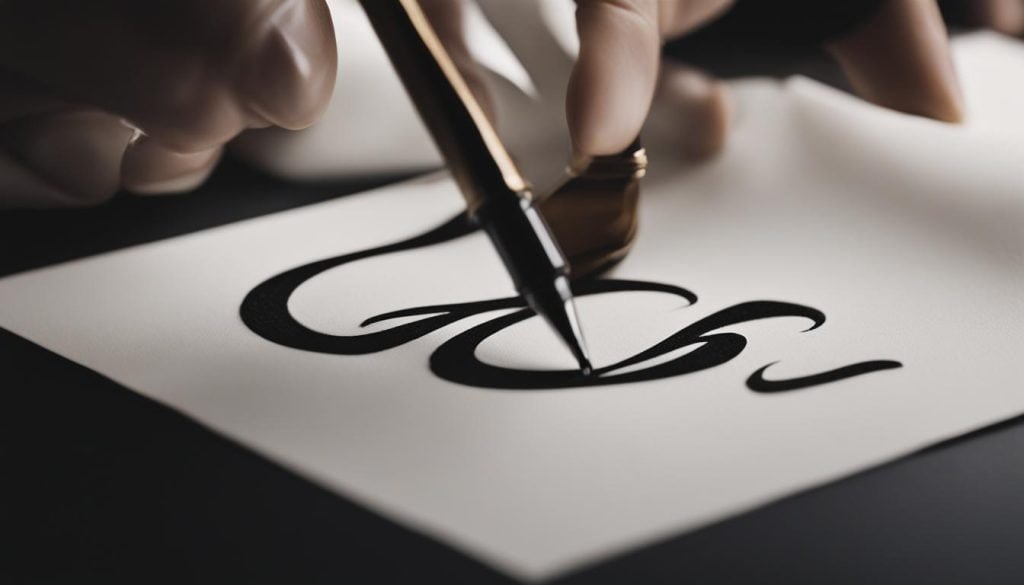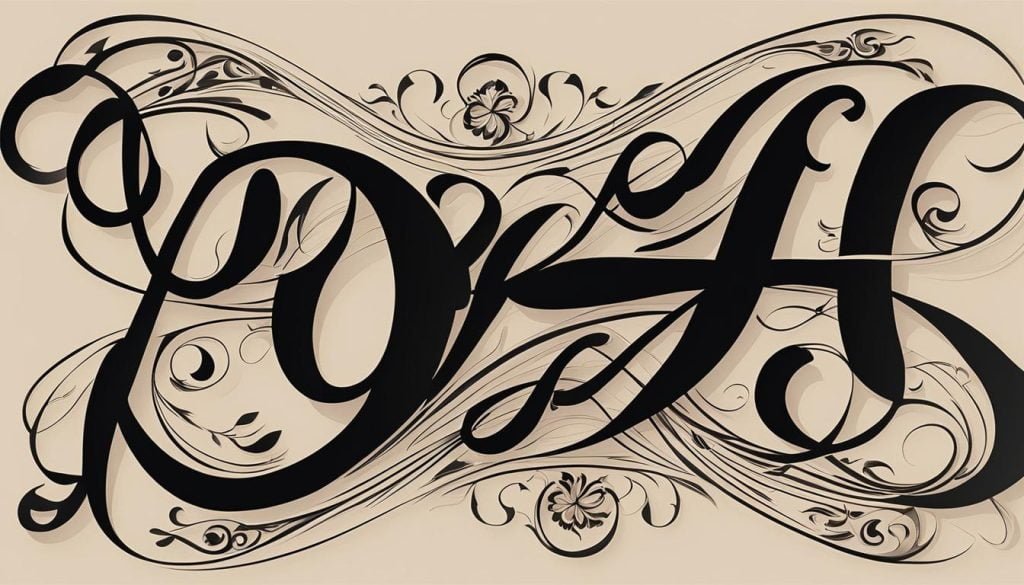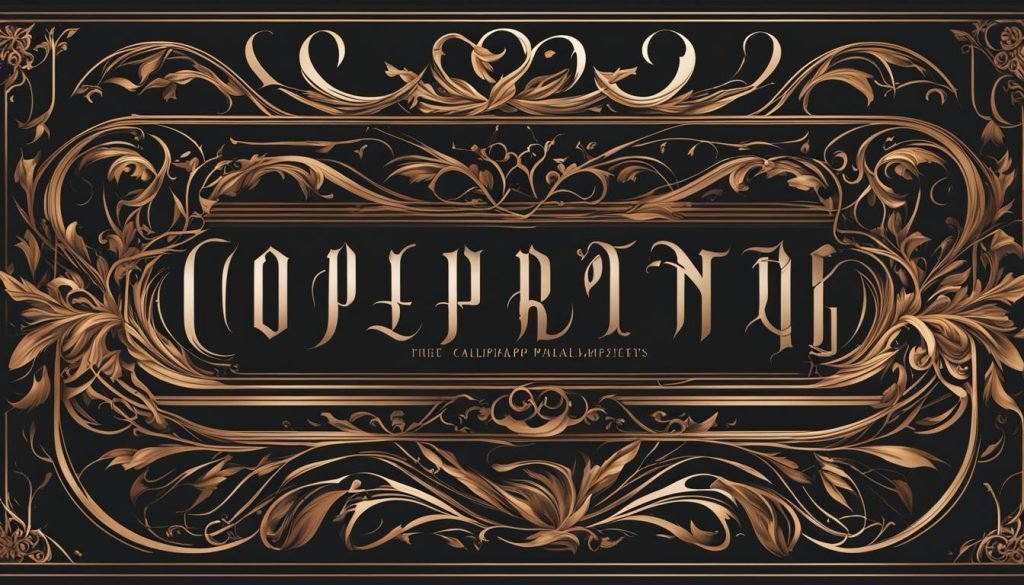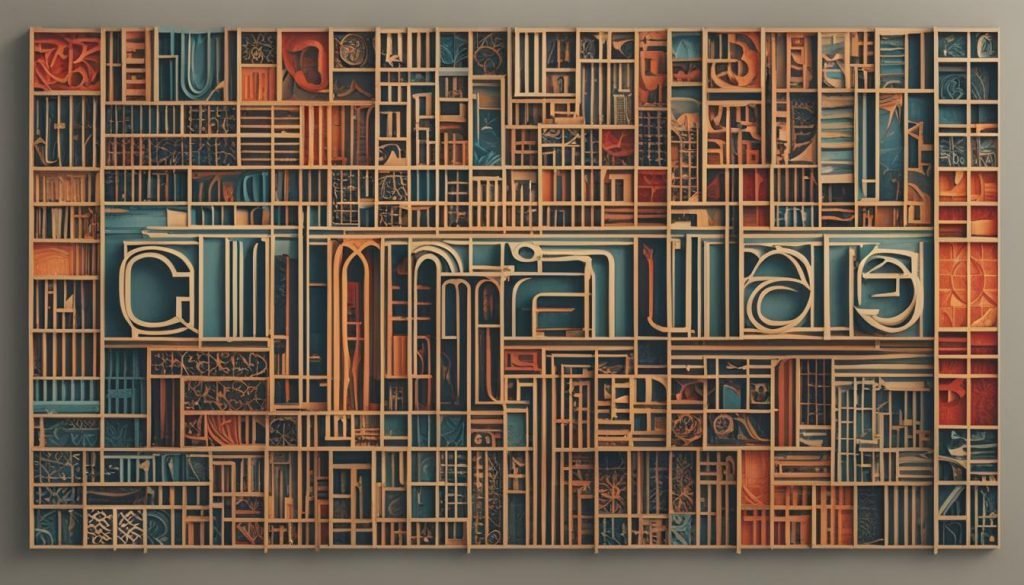Calligraphy Letterform Variations: Discover the Art of Creating Unique and Creative Letters
Welcome to our article on calligraphy letterform variations and the world of creative letters! Calligraphy is a beautiful art form that allows for endless possibilities in lettering styles and designs. From traditional scripts to modern techniques, calligraphy offers a captivating way to express your creativity and create unique alphabets. Whether you’re a beginner or an experienced calligrapher, this article will inspire you to explore different letterforms and discover the beauty of calligraphy.
Throughout this article, we will delve into various aspects of calligraphy, including how to write the alphabet in calligraphy, creating your own alphabets, exploring historical styles, and even delving into the history of type design. We will also provide practical tips on creating variation in your letterforms and discuss important terms in the world of calligraphy and lettering.
To help you visualize the concepts discussed, we have included relevant images and examples. Take a look at the image below to get a glimpse of the creative possibilities that await you in the world of calligraphy.
Key Takeaways:
- Calligraphy offers a wide range of letterform variations, from traditional to modern styles.
- Writing calligraphy letters requires attention to detail, stroke by stroke.
- You can create your own unique calligraphy alphabet and even develop your own calligraphy font.
- Copperplate is a popular traditional calligraphy script.
- Digital tools can be used to create calligraphy alphabets and explore the combination of traditional and digital techniques.
How Do You Write The Alphabet In Calligraphy?

Writing calligraphy letters is a creative and artistic process that requires attention to detail and precision. Unlike handwriting cursive, calligraphy letters are formed one stroke at a time, with careful consideration given to each stroke’s entrance, oval, and underturn. To write the alphabet in calligraphy, you will need the proper tools and techniques. Let’s explore the step-by-step instructions:
- Choose the right tools: Start by selecting a calligraphy pen or brush that suits your preference. Traditional flexible nib pens or brush pens are commonly used for calligraphy.
- Prepare your workspace: It’s important to have a clean and organized workspace to ensure smooth and uninterrupted writing. Set up your calligraphy paper, ink, and pen in a comfortable position.
- Begin with basic strokes: Before diving into the alphabet, practice basic strokes like the upward stroke, downward stroke, and curved stroke. This will help you get familiar with the movement and pressure needed to create beautiful letterforms.
- Start with the letter “A”: Begin by writing the letter “A” in calligraphy. Start with a diagonal stroke from the top left corner towards the bottom right corner. Lift your pen and create a curved stroke connecting the diagonal line. Finish by adding a thin horizontal stroke across the middle.
- Continue with the rest of the alphabet: Once you’ve mastered the letter “A,” move on to the rest of the alphabet, one letter at a time. Pay attention to the unique characteristics and flourishes of each letter.
- Practice and refine: Calligraphy is a skill that improves with practice. Experiment with different letter sizes, angles, and styles to develop your own personal calligraphy style.
Remember, patience and practice are key when learning calligraphy. Take your time, enjoy the process, and don’t be afraid to make mistakes. With dedication and practice, you’ll be able to write the alphabet in calligraphy with confidence and creativity.
Creating Your Own Alphabets
While traditional calligraphy letters adhere to strict rules, modern calligraphers have the freedom to create their own alphabets and explore different styles. Whether you’re looking to add a personal touch to your lettering or develop your own calligraphy font, the possibilities are endless. Let’s dive into the world of creating your own calligraphy alphabets and font-making.
Traditional vs. Modern Calligraphy
When it comes to creating your own alphabet, you have the option to embrace the traditional or venture into modern styles. Traditional calligraphy follows established rules and guidelines, such as the vertical stress of Copperplate or the thick and thin strokes of Spencerian. On the other hand, modern calligraphy allows for more experimentation and personal expression. It’s all about finding a style that resonates with you and reflects your artistic vision.
Ornate vs. Minimalist Styles
Another consideration when creating your own alphabets is the level of ornateness or minimalism you want to incorporate. Some calligraphers prefer intricate details and flourishes, while others opt for a clean and minimalist approach. Experimenting with different ornamentations, swirls, or simple and sleek letterforms can help you define your own unique style and aesthetic.
Turning Your Alphabet into a Font
Once you’ve created your own calligraphy alphabet, you may want to transform it into a digital calligraphy font. This allows you to easily use your custom alphabets in projects, such as digital artwork, invitations, or graphic design. There are various resources and tutorials available online that guide you through the process of making your own calligraphy font, ensuring your letterforms are translated accurately into digital form.
Copperplate Calligraphy Alphabets

Copperplate is a classic and elegant style of calligraphy that originated in the 18th century. Known for its flowing lines and delicate strokes, Copperplate calligraphy has remained popular among calligraphers and lettering enthusiasts. This section will explore different variations of Copperplate alphabets, showcasing their unique features and offering inspiration for your own lettering projects.
In Copperplate calligraphy, the lowercase letters are characterized by their oval shapes and subtle flourishes. The uppercase letters, on the other hand, are more ornate with dramatic loops and flourishing details. The contrast between the thin upstrokes and thick downstrokes gives Copperplate lettering its distinct look.
To help you visualize the different styles and variations, below is a table showcasing the Copperplate lowercase and uppercase alphabets:
| Lowercase Alphabets | Uppercase Alphabets |
|---|---|
| a | A |
| b | B |
| c | C |
| d | D |
| e | E |
| f | F |
| g | G |
| h | H |
| i | I |
| j | J |
| k | K |
| l | L |
| m | M |
| n | N |
| o | O |
| p | P |
| q | Q |
| r | R |
| s | S |
| t | T |
| u | U |
| v | V |
| w | W |
| x | X |
| y | Y |
| z | Z |
These examples represent just a fraction of the possibilities within Copperplate calligraphy. As you continue to practice and explore this beautiful lettering style, you can add your own personal touches and variations. Remember, calligraphy is an art form that allows for creativity and individual expression, so don’t be afraid to experiment and make each letter your own.
Whether you’re creating wedding invitations, designing logos, or simply want to enhance your everyday handwriting, Copperplate calligraphy provides a timeless and sophisticated option. The elegance of this style is sure to impress and captivate your audience, making it a valuable skill to master.
Digital Copperplate Calligraphy Alphabets

Digital technology has revolutionized the art of calligraphy, offering new possibilities for creating beautiful lettering. With the use of modern tools like the iPad and the Procreate App, calligraphers can now explore traditional scripts like Copperplate in a digital format. Digital Copperplate Calligraphy Alphabets combine the elegance and precision of the traditional script with the convenience and versatility of digital platforms.
Using the Procreate App on the iPad, calligraphers can easily create smooth and precise strokes, experimenting with different line weights and flourishes. The digital format also allows for the undo and redo functions, making it easier to correct mistakes and refine letterforms. Artists can try out different variations of Copperplate alphabets, adjusting the spacing, slant, and embellishments to create their own unique style.
“Digital Copperplate Calligraphy Alphabets offer a new level of control and precision to calligraphers. The ability to zoom in and work at a pixel level allows for intricate details and flawless lines. It’s a perfect fusion of traditional elegance and modern convenience.”
One of the advantages of Digital Copperplate Calligraphy Alphabets is the ability to easily transform them into scalable vector graphics. This means that the letterforms can be resized without losing any quality or clarity, making them suitable for a wide range of applications, from small-scale designs to large-scale projects like signage or murals. Digital Copperplate Calligraphy Alphabets also open up possibilities for combining with other digital elements, such as incorporating them into digital artwork or digital calligraphy compositions.
As technology continues to evolve, the digital medium offers endless opportunities for calligraphers to push the boundaries of their art. Digital Copperplate Calligraphy Alphabets showcase the seamless marriage of traditional script and modern tools, allowing artists to create stunning lettering with precision and ease. Whether you’re a traditional calligraphy enthusiast looking to explore new avenues or a digital artist seeking to incorporate calligraphy into your work, Digital Copperplate Calligraphy Alphabets offer a wealth of possibilities for creativity and self-expression.
The History of Type Design and Calligraphy

Before the advent of digital type, letterforms were handcrafted through metal casting or wood carving. The art of calligraphy dates back thousands of years, with ancient civilizations like the Egyptians and Romans using intricate scripts to communicate and record information. Over time, different cultures developed their own unique calligraphy styles, each with its own set of rules and aesthetic principles. From the elegant lines of Chinese brush calligraphy to the ornate flourishes of Islamic script, calligraphy has evolved into a diverse and expressive art form.
During the Middle Ages, calligraphy played a crucial role in book production, as scribes meticulously transcribed religious texts and illuminated manuscripts. These handcrafted books showcased the beauty and skill of calligraphers, with intricate letterforms and elaborate embellishments adorning each page. The invention of the printing press in the 15th century revolutionized the field of typography, making it possible to produce multiple copies of books and documents with greater speed and accuracy.
“Typography needs to be audible. Typography needs to be felt. Typography needs to be experienced.”
— Helmut Schmid
With the rise of digital technology in the late 20th century, calligraphy and type design entered a new era. Designers now have access to a wide range of digital tools and software that allow them to create and manipulate letterforms with ease. However, the art of calligraphy and the traditional techniques of hand lettering continue to be revered and practiced by artists and enthusiasts around the world.
The Evolution of Calligraphy
Calligraphy has experienced a rich and varied evolution throughout history. Each era and culture has left its mark, contributing to the development of different scripts and letterforms. Here are some key milestones in the history of calligraphy:
- Ancient calligraphy: From Egyptian hieroglyphics to Roman capitals, the ancient world laid the foundation for early calligraphy.
- Medieval calligraphy: The Middle Ages witnessed the rise of Gothic script and illuminated manuscripts, with calligraphy playing a vital role in religious texts.
- Renaissance calligraphy: The Renaissance period saw a revival of interest in classical calligraphy, with artists like Nicolas Jenson and Albrecht Dürer creating influential typefaces.
- Modern calligraphy: The 20th century brought new styles and techniques, from the elegant Spencerian script to the bold, expressive lettering of the Art Nouveau and Art Deco movements.
Today, calligraphy continues to evolve and adapt to new technologies and artistic influences. From traditional pen and ink techniques to digital lettering and typography, calligraphers and type designers are pushing the boundaries of the art form, creating innovative and captivating letterforms.
The Impact of Calligraphy on Type Design
Calligraphy has had a profound influence on the development of type design. In the early days of typography, typefaces were modeled after handwritten letterforms, with calligraphers often playing a dual role as type designers. The skill and craftsmanship of calligraphers helped shape the aesthetic principles of type design, with an emphasis on legibility, proportion, and rhythm.
Even with the advent of digital type, calligraphy continues to inspire and inform the work of type designers. Many contemporary typefaces draw inspiration from calligraphy, incorporating its fluid strokes and elegant curves into their designs. The artistry and attention to detail that are synonymous with calligraphy are reflected in the meticulously created letterforms of modern typefaces.
| Calligraphy Style | Key Characteristics | Notable Examples |
|---|---|---|
| Blackletter | Distinctive bold and angular letterforms | Gothic, Fraktur |
| Copperplate | Graceful, flowing letterforms with delicate hairlines | Spencerian, Engravers Script |
| Italic | Sloping, cursive letterforms | Adobe Garamond, Baskerville |
| Modern Script | Flourished, flowing letterforms with varied stroke contrast | Brush Script, Carolyna Pro |
| Hand Lettering | Unique, custom letterforms created by hand | Creative lettering pieces and custom logos |
Important Terms in Calligraphy and Lettering
When diving into the world of calligraphy and lettering, it’s important to familiarize yourself with key terms and concepts. Understanding these terms will help you navigate the art and craft of beautiful letterforms. Here are some important terms you should know:
1. Calligraphy
Calligraphy is the art of writing beautifully. It involves the skilled execution of letterforms with a pen or brush. Calligraphy is often used for decorative purposes, such as invitations, certificates, and signage.
2. Lettering
Lettering refers to the art of drawing or creating individual letters. Unlike calligraphy, lettering focuses on the design and composition of letterforms, often incorporating different styles, shapes, and embellishments.
3. Typography
Typography is the arrangement and design of typefaces to create visually appealing text. It encompasses the selection of fonts, spacing, and layout to convey a specific message or evoke a particular aesthetic.
4. Typeface
A typeface is a set of letterforms that share a consistent design. Examples of typefaces include Times New Roman, Arial, and Helvetica. Each typeface can have various styles, such as bold, italic, or condensed.
5. Font
A font refers to a specific size, weight, and style of a typeface. For example, Arial Regular 12pt is a font, while Arial Bold 14pt is a different font within the Arial typeface family.
These are just a few of the fundamental terms in the world of calligraphy and lettering. By familiarizing yourself with these terms, you’ll be better equipped to appreciate and create beautiful letterforms.
Creating Variation in Letters
In order to develop your own unique calligraphy style, it’s important to create variation in your letterforms. By playing with different elements of your lettering, you can add personality and creativity to your work. Let’s explore some ways to introduce variation:
Weight:
Varying the thickness and thinness of your strokes can create visual interest in your letters. Experiment with different nib sizes and pressures to achieve contrasting weights. This will give your lettering depth and dimension.
Contrast:
Contrasting strokes within each letter can make your calligraphy stand out. Play with different stroke widths, angles, and directions to create dynamic forms. Emphasize the downstrokes while keeping the upstrokes lighter for a classic calligraphy look.
Spacing:
The spacing between letters and words can greatly affect the overall look of your calligraphy. Experiment with tighter or looser spacing to create different moods in your lettering. Remember to maintain consistency and readability while pushing the boundaries of spacing.
Angles or Slant:
Adjusting the angle or slant of your letters can create a sense of movement and flow in your calligraphy. Play with different angles to find the one that best suits your style and the overall composition of your lettering piece.
Embellishments:
Adding embellishments such as loops, swirls, flourishes, or decorative elements can give your calligraphy a unique touch. These embellishments can be placed at the beginning or end of a word, or incorporated within the letters themselves. Experiment with different embellishment styles to find your own signature look.
By incorporating these variations into your letterforms, you can take your calligraphy to the next level. Be bold, experiment, and let your creativity guide you as you develop your own unique style.
Historical Calligraphy Alphabets
Explore the diverse world of historical calligraphy alphabets and discover their unique features and characteristics. From the elegant Imperial Capitals to the elaborate Gothic Capitals, each historical style offers its own charm and inspiration for calligraphers.
Here are some notable historical calligraphy alphabets:
- Imperial Capitals: Known for their grandeur and symmetry, Imperial Capitals were commonly used in ancient Rome.
- Textura Quadrata: This Gothic script features dense, black letters with sharp corners and is often associated with medieval manuscripts.
- Caroline Minuscule: Developed during the Carolingian Renaissance, this elegant script is characterized by its tall, slender letters.
These are just a few examples of the rich history of calligraphy alphabets. Each style has its own set of rules and techniques, offering calligraphers a wealth of possibilities for lettering projects.
| Calligraphy Alphabet | Features |
|---|---|
| Imperial Capitals | Grandeur, symmetry |
| Textura Quadrata | Dense, black letters with sharp corners |
| Caroline Minuscule | Tall, slender letters |
Conclusion – Calligraphy Letterform Variations
In conclusion, calligraphy letterform variations offer endless opportunities for creative expression. Whether you’re a novice or a seasoned calligrapher, exploring different lettering styles and techniques can enhance your penmanship and ignite new artistic endeavors. By mastering the fundamentals and experimenting with various alphabets, you can cultivate your own unique calligraphy style and produce stunning letters that reflect your personal artistic vision.
Throughout this article, we have delved into the beauty and diversity of calligraphy alphabets, from traditional scripts like Copperplate to modern styles like brush lettering and hand lettering. We have seen how technology has transformed the way calligraphy is practiced, with digital tools allowing for a seamless blend of traditional and digital techniques.
Furthermore, we have explored the history of type design and calligraphy, gaining insight into the craftsmanship and evolution of letterforms. Understanding key terms and concepts in calligraphy and lettering is crucial for developing a solid foundation in this art form.
So, whether you’re captivated by the ornate flourishes of historical calligraphy alphabets or prefer to create your own innovative letterforms, the world of calligraphy is ripe with opportunities for self-expression and artistic growth. Embrace the journey and let your creative spirit soar!
FAQ – Calligraphy Letterform Variations
What are the different styles of calligraphy alphabets?
The calligraphy alphabet can take almost any form, including traditional styles like Copperplate, Spencerian, and Blackletter, as well as modern styles like bounce lettering, brush lettering, and hand lettering.
How is calligraphy different from cursive handwriting?
Calligraphy letters are created one stroke at a time, with attention to each stroke’s entrance, oval, and underturn, whereas cursive handwriting involves connecting letters in a flowing manner.
Can I create my own calligraphy alphabets?
Yes, you have the freedom to create your own calligraphy alphabets. You can explore different styles, from traditional to modern, and experiment with ornate vs. minimalist designs, flat vs. 3D styles, and standard vs. unique letterforms.
How can I turn my own alphabet into a calligraphy font?
There are resources and tutorials available for font-making. You can learn how to transform your own alphabet into a calligraphy font, allowing you to use it digitally.
What is Copperplate calligraphy?
Copperplate is one of the most popular traditional calligraphy scripts. It features thin upstrokes and thick downstrokes, creating an elegant and sophisticated look.
Can Copperplate calligraphy be done digitally?
Yes, Copperplate calligraphy can also be created using modern digital tools. Examples of Copperplate alphabets created on the iPad using the Procreate App and an Apple Pencil will be showcased.
What is the history of type design and calligraphy?
Before the advent of digital type, letterforms were handcrafted through metal casting or wood carving. This section will provide a brief history of type design and calligraphy, explaining how different scripts and alphabets contributed to the diversity of letterforms we have today.
What are some important terms related to calligraphy and lettering?
Important terms include calligraphy, lettering, typography, typeface, font, alphabet, hand, and more. This section will define these terms to provide a solid foundation in the terminology used in the world of calligraphy and lettering.
How can I create variation in my calligraphy letterforms?
There are different ways to create variation, such as playing with weight, contrast, spacing, angles or slant, and embellishments. This section will explore these elements and how they can add personality and creativity to your lettering projects.
What are some historical calligraphy alphabets?
Historical calligraphy alphabets include Imperial Capitals, Rustic Capitals, Square Capitals, Insular Majuscule, Caroline Minuscule, Foundational Hand, Textura Quadrata, Gothic Capitals, Bastard Secretary, Rotunda, Humanist Minuscule, Italic, and Copperplate. Each style has its unique features and characteristics.




